spiritual questions and answers PART 16 By Prof. G. Venkataraman |
||
Since Heart2Heart started in 2003, readers have very often written to us seeking answers to many spiritual questions. We have answered them at times through appropriate articles in H2H. However, there are still many that have to be explained carefully and in detail. And in the recent past, a lot more queries have arrived on varied topics concerning spirituality and personal growth.
We have now meticulously compiled and categorised these questions, and Prof. G. Venkataraman has offered to answer all these queries in a structured and systematic way as a series on Radio Sai as well as in H2H. In this way, these answers now remain always on our website as a ready reckoner on spiritual doubts. This is a suitably adapted transcript of our radio series bearing the same name.
Loving Sai Ram, and greetings from Prasanthi Nilayam. If you recall, we are currently on the theme of the Five D’s, that is to say, the quintet consisting of discipline, devotion, dedication, determination and discrimination. The first question for this issue relates to discipline, and it is as follows:
QUESTION: The need for discipline in our life is clear. But I feel that discipline also sometimes acts as an obstacle to creativity and spontaneity. To tap the creativity in an individual, we need to provide him some “free space”.
Basically, the questioner is making a comment, arguing for some exemptions to what is called discipline. On the face of it, I am sure that most artists and musicians would go along with this view. However, if we are to answer this question properly, we must be clear about many things, including the real meaning of the word discipline on the one hand and creativity on the other. Let us explore our way through this slightly tricky issue, slowly and carefully.
I shall start with creativity, because once we are clear about it, I expect the other points would fall into place more easily. Yes, humans do display remarkable creativity in diverse fields. Indeed, over the centuries, there have been amazing displays of ingenuity and creativity in art, music, architecture, crafts of various kinds, and of course also in science and technology.
There is simply no way in which all this can ever be dismissed or even underestimated. That said, it is well to remember, and in full humility too I might add, that whatever creativity one is blessed with, is actually a gift of God – Krishna makes that very clear in His Discourse to Arjuna in the Bhagavad Gita.
 |
 |
 |
However, these days when the existence of God Himself is in doubt for many people, quite a few tend to feel that whatever creativity they have been privileged to display, is entirely due to their own struggles and efforts, at times against many odds. I shall instead take the view that whatever creativity we might have, is entirely a gift of God, and proceed with my answer on that basis.
Next, we need to come to some agreement about the word discipline. Yes, discipline does have some relevance to regularity in habits, being meticulous, etc. It has also relevance to being principled and so forth. But more than anything else, I personally would interpret discipline in a larger sense by defining it as a code that makes sure we do not transgress the boundaries of Sathya, Dharma, etc.
 |
Now there are many reasons why I am saying this, and let me give one example, dealing with the issue of artistic liberties. All artists claim such a freedom, with some insisting on being totally uninhibited; that is to say, for them there are no red lines whatsoever. Thus when some artists make paintings showing goddesses in what the devout consider as obscene situations, the “liberated” people argue, “What are you objecting about?
Are you not aware of the erotic sculptures to be found in many ancient temples? When they could do it, why cannot this much-maligned artist? You are an old-fashioned fuddy-duddy, absolutely out of touch with modernity, and a dangerous obscurantist.” And so on.
To many modern people, all this might sound perfectly logical. The basic point they make is: “In the name of religion, popular sentiment and so forth, creativity is being inhibited. Why should it be, when artists of the past were allowed to do the same sort of things and that too in temples? How retrograde can you get!”
Well, my point is this. Just because a certain thing was done earlier, does that mean one should it again, especially when it is likely to hurt sentiments? One should be careful about advancing such arguments. I mean, suppose one says, “People had slaves in the old days, and therefore why should I too not have a slave?” Maybe, this would be dismissed as a ridiculous argument, which indeed it is. But, while so dismissing the argument about continuing slavery, one must examine on a similar basis the case being made for artistic freedom guided by so-called past precedents.
I agree that artists must have the freedom to give expression to their creativity. The question I ask is: “Can they not do so without giving offence to the sentiments of a large number of people?” Let me pursue my argument further with some comments on music, and the way it is rendered at various times by various artists.
I am a fan of classical Indian music, and where Carnatic or South Indian classical music is concerned, I know for a fact that many contemporary musicians have experimented with departures from the traditional styles. While some die-hard conservatives did not always approve such explorations of creativity, there were others who heartily endorsed it; at the same time, no one accused those who dared to experiment with new styles as having mala-fide intentions.
God is more concerned with the feelings that motivate one’s actions rather than the technicalities. |
In short, it all boils down to what one means by “free-space”. In my view, if free-space does not imply the freedom to hurt the sentiments of others in any way, etc., then I guess one cannot complain seriously. I mean if you take painting, not many appreciate the fact that to some extent, painting styles evolved with the availability of various kinds of paints. For example, when water colours became available, they gave rise to a style of their own. Similarly, one fine day, someone discovered cartoons, and since then, newspapers have used cartoons for expressing humour. As long as the humour is not deliberately malicious, departure from the realistic style to convey a message is an example of creativity that is perfectly acceptable.
In short, what I am saying is that claiming infinite “free space” and thereby also the right to do what one wants in the name of artistic creativity, is a false argument. What is worse is that in the name of liberty, the very people who draw red lines as convenient to them also observe double standards. Although I do not wish to get into political matters in this article, I am compelled to draw attention to some recent incidents by way of reiterating my point.
Sometime ago, there were cartoons in newspapers published in Western Europe that offended Muslim sentiment worldwide. This started a big debate, in which the Western press took the view that they had perfect freedom to do what they wanted and if someone was offended, that was not their problem. However, when it comes to what is known as the Holocaust, there is a law, applicable in France [and possibly all across the European Union, although I am not quite sure about the latter], that anyone denying that the Holocaust actually happened, is liable for punishment by law.
 |
 |
 |
Here is a classic case of double standards. If artists in Western Europe could be granted freedom of artistic expression, then why cannot others in that same region be granted the freedom to say what they want? After all, the Media constantly touts freedom of expression. The argument given is that if one denies the Holocaust which did happen and caused untold suffering to millions who perished, then it hurts the sentiments of millions alive today, who have in one way or the other affected by the Holocaust.
That exactly is my point. Holocaust denial is NOT permitted because such denial would hurt the sentiments of millions. So I ask, “How come then are artists allowed to hurt the sentiments of others? Why not instead, artists, especially those who are hailed as great masters, observe self-restraint and avoid doing painting that are likely to hurt the sentiments of millions? Why cannot the defenders of such offenders see the point and stop arguing for uninhibited license for artists in the name of freedom? If freedom is the buzz word, then what about unlimited freedom to other sections of society?
What about unrestricted freedom to scientists, businessmen, etc.?” You can see where all this would lead to. I submit therefore that if peace is what should be preserved, then people should voluntarily observe red lines. Who knows, in course of time, people would become more liberal and fault tolerant; in which case why not wait?
Having said all that, from the point of Spirituality, the issue is crystal clear. Every single individual is expected to voluntarily observe red lines implied by Dharma, and one of these is that one must never do anything likely to cause injury or harm to any individual, either in body or mind; much less to large segments of society. In other words, in the Spiritual domain, the individual becomes distinguished by the moral restraints he or she observes, rather than the hurt caused in the name of free expression of creativity.
Well, with that I have exhausted all the questions sent to us and dealing with the so-called Five D’s. Before I move on to the next topic, I would like to tie up the many things I have said while dealing with questions under this particular head.
Basically, the Five D’s as I have been referring to them, form a package of essentials in one’s effort to become Spiritually Pure. Remember that the core of Spiritual Purity is a must for achieving complete and non-stop harmony of feelings, thoughts, words and deeds. It is only such constant internal purity that would lead to Selflessness, which is a must for one on the Spiritual path.
The next point we have to bear in mind is that life is full of actions, and actions must be such as not to harm others. If that is conceded, then clearly, every time one acts, one must do a careful check as follows:
Is this action good or is likely to be contaminated with selfish and other undesirable intentions?
Would it in anyway compromise the must-have harmony of thought, word and deed?
 |
All this calls for proper Spiritual Discrimination, or Buddhi, which, you would remember is one of the Five D’s.
In short, the Five D’s are like the missile shield that many countries use to protect themselves against attack by missiles coming from other countries. In this case, the enemies we have to protect ourselves from are – I am sure you know the list, don’t you? Anyway, for the record, let me state them again. They are: Kama or desires of all sorts, Krodha or anger, Lobha or miserliness, Moha or attachment, Mada or pride, and Matsarya or jealousy.
Time to move on to a new topic, and it is what is called Spiritual Practices. There are many questions under this heading, the first of which is:
Question: What kind of Japa (chanting of Divine name) is more powerful, loud or mental?
Before I attempt to answer this question, I guess I should perhaps say a few words about what is referred to as Japam. Basically, japam is an ancient Hindu ritual involving chants of some kind or the other; the practice itself goes back to the Vedic times.
There are many types of japams, and here is a partial list.
There is the Gayathri Japam which essentially consists of repetitive chanting of the Gayathri Mantra. Then there is the Kamya Japam where a particular Mantra is chanted for some specific reasons like getting cured of a health problem, obtaining wealth, etc. There is also the Prayaschitta Japam where the chant is done by way of atoning for some sins committed. I should not forget to include in my list Likhita Japam which consists of writing a particular Mantra.
 |
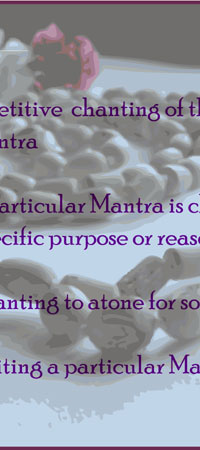 |
 |
Likhita Japam is fairly common amongst Sai devotees; in fact, in Prasanthi Nilayam special note books are sold wherein one could write ‘Om Sri Sai Ram’ repeatedly. Needless to say, the writing must be done silently, and focussing on the deity to whom the writing is addressed.
Turning now to the procedure, japam could be practiced in three different ways. It could be chanted loudly, or whispered, or it could be done silently. A rosary or japamala is sometimes used for keeping count of the chants made.
So much for the technical and the traditional aspects of japam. To these remarks I would like to add that in the ultimate analysis, God is more concerned with the feelings that motivate one’s actions rather than on technicalities. Starting from that basis, let me now deal with the question raised; after that, I shall cite an incident in the epics that lends strong support to my point of view.
 |
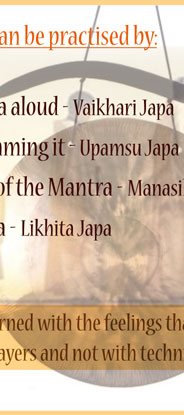 |
 |
Let us start with the question: “What for does one engage in japam?” If one goes to the root of the answer, one would agree that leaving out the cases where japam is done for gaining some benefits, japam is just one of the many routes for getting closer to God and becoming dearer to Him. This raises the question: “Can one describe the person who is dear to God?” Fortunately, I do not have to make any special effort to answer that question because God Himself has very clearly spelt out the answer.
I am referring to what Krishna states in the famous Twelfth Chapter of the Gita, popularly known as Bhakti Yoga. I shall not go into the details here, partly in the hope that this would arouse your curiosity and trigger you to doing some exploration yourself; I assure you that should you do so, you would find it extremely rewarding.
I should not forget to add that Swami, who we all agree is Krishna come again, has not changed the specifications one tiny bit; not even a comma has been changed, which means that the specs for becoming dear to God remain the same even now.
So what does all that mean with respect to japam? According to me it means the following: “Irrespective of whether one does the japam loudly or mentally, reciting the verses involved, should make one dear to the Lord in the sense the Lord Himself has described.” I hope this makes clear that the exact procedure adopted is less important than the motivation and feelings that accompany the procedure concerned.
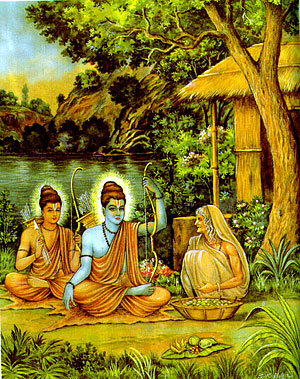 |
Assuming that I have got my point across let me now discuss the example I referred to earlier. In the Ramayana, there is a beautiful scene that occurs when Rama and Lakshmana are wandering in search of Sita who had been abducted earlier. During their wanderings in the forest, they meet an old tribal lady, Sabari.
This woman had earlier been told by her sage and master that one day, the Lord would come to the forest and that she should wait for Him. Sabari in full faith, decided to wait for the Lord, although she had the faintest idea of how the Lord would look, how He would come, etc.
In spite of lack of knowledge of these vital practical details, Sabari just waited, having total faith in her master’s words. Not merely that; every single day, she would collect fresh fruits such as were found in the forest, holding them as an offering, should the Lord manifest.
One fine day Sabari saw Rama and Lakshmana come along. They were dressed like hermits but they carried bows and arrows, which sages did not. Going by these characteristics alone, there was no reason to suppose that Rama was verily God in human form.
However, when Sabari saw Rama, she saw Him not only with her eyes, but also with her Heart; and the Pure Love for the Lord in her Heart, instantly recognised the Lord, coming to her in the form of Rama.
And what did Sabari do the moment she recognised that Rama was indeed the Lord for whom she had been waiting for so long? She greeted Him and of course Lakshmana too, with the broadest of smiles and Love gushing forth as a torrent from her heart. She washed the feet of the Princes, prostrated before them, and then offered the fruits she had lovingly gathered earlier in the day.
The Lord is concerned only about the extent to which our heart is filled |
Now it is quite usual to make offerings to the Lord, both during formal worship at home and also when the Lord comes in human form. The unique thing about what Sabari did was, that being a simple tribal woman totally ignorant of the rules of etiquette, she bit into every fruit first, tasted the bit she had chewed off, made sure the fruit selected was sweet enough, and then offered it to Rama and Lakshmana.
Just pause and think about it calmly for a minute. Would any one of us ever dream of doing something like this, when say we offer a fruit to Swami, who of course is Rama come again? Yet that is precisely what Sabari did! Now how did Rama react to all this? Did He flinch, did He mutter, ‘Oh look at this tribal woman, she does not know the a,b,c of proper behaviour!’ or anything like that? Not at all; on the other hand, Rama not only received the offering with much Love but ate every selected fruit, making it very evident how much He relished the fruit offered.
 |
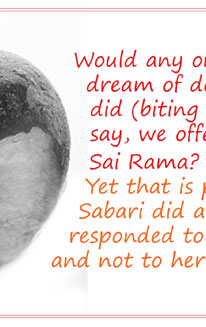 |
 |
In the Ramayana, the Sabari interlude is very brief but a very significant one; that is why not only scholars attach much importance to it but Saint Tyagaraja, who, I confess is a favourite musician of mine, composed a beautiful song entirely in celebration of Sabari, wondering how he could describe the amazing Grace that she received?
Getting back to the point I am trying to put across, at the end of the day, the Lord is least bothered about the extent of our textual knowledge of the scriptures, or about how many rituals we perform, how frequently we do them, etc. The Lord is concerned only about the extent to which our heart is filled with Pure Love for Him. That is what the story of Sabari highlights.
Yudhishtra asks: “Which japam amongst the many is the best of them all?” And in response, Bhishma says, “It is, without any question, the chanting the Name of the Lord!” Chanting the Name of the Divine Lord is superior even to chanting the Vedas! |
My own suggestion is that anytime we start wondering about rituals, technicalities and things like that, all we have to do is to recall the saga of Sabari, and immediately our perspective would get properly aligned in the right direction.
Before leaving this topic, maybe I should call your attention to a couple of other points that are related. The first concerns the famous advice that the venerable Bhishma gave on his death bed to the eldest of the Pandavas, namely Dharmaputra, also known as Yudhishtra. The advice was sweeping, covering many topics ranging all the way from various aspects of governance, right down to what individuals ought to do.
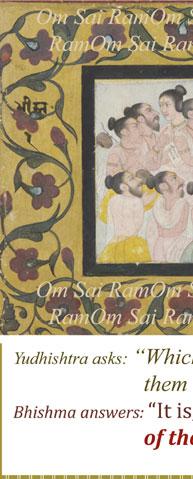 |
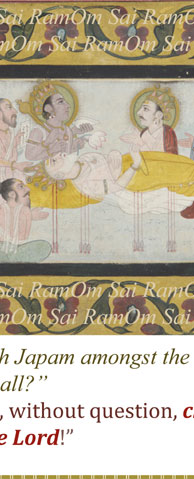 |
 |
Somewhere during the conversation, Yudhishtra asks: “Which japam amongst the many is the best of them all?” And in response, Bhishma says, “It is, without any question, the chanting the Name of the Lord!” By the way, Swami has confirmed this, adding that chanting the Name is superior even to chanting the Vedas! I hope you would take notice of that. By way of adding a footnote, I might mention that Bhishma, after giving the reply he did, then went on to chant the thousand different ways Lord Narayana could be hailed, and this is the famous Vishnu Sahasranamam.
Some of you might remember that Shirdi Baba stressed that devotees of the Lord would do well to chant Vishnu Sahasranamam regularly, and indeed even to this day, they play every morning in Shirdi, a recording of this famous Chant.
 |
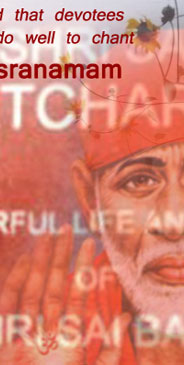 |
 |
Getting back to the basic question of chanting the Name, some ask: “The Lord has so many Names; by which particular Name do we hail Him? Should it be Rama, or Krishna, or Allah, or Jesus?” Good question, and the answer is contained in a Bhajan that we all sing, starting with the words, “Govind bolo, Gopal bolo …..” In that Bhajan occurs a line that contains the answer to the question that I raised. The answer that the Bhajan gives is: “Chant any Name you like, but when you chant, do so with Love and deep feeling!”
I think that is all I can cover for this issue. Jai Sai Ram.
Dear Reader, how do you like this series? Does it help you in any way? Do you have any spiritual questions which need clarification? Please feel free to write to us at h2h@radiosai.org mentioning your name and country. Thank you for your time.






